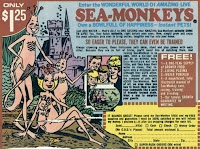 As I've mentioned previously, I've been finding a limiting factor in rearing Marmorkrebs to be getting them from early juvenile to the late juvenile stage. Now, I read in a new paper by González and colleagues that this is a fairly typical problem for aquacultured crayfish. They write:
As I've mentioned previously, I've been finding a limiting factor in rearing Marmorkrebs to be getting them from early juvenile to the late juvenile stage. Now, I read in a new paper by González and colleagues that this is a fairly typical problem for aquacultured crayfish. They write:The main constrains to intensified astacid culture are the unpredictable and usually poor survival and growth rates of juveniles during the first months of independent life, when feeding is a decisive factor(.)
Part of their solution to this problem is not one I probably would have thought of: Artemia.
Artemia, also known as brine shrimp, are tough little crustaceans. Aquarium owners have used them as live food for various tropical fish for decades. Some people have them in aquaria just on their own -- they were sold for years, and are still sold, as "Sea monkeys." The picture shown is one that any comic reader of a particular age will recognize. (And yes, I'm of that particular age).
I hadn't considered Artemia as crayfish food for a couple of reasons. First, I associate them more with salt water, as they usually live in inland salty lakes, rather than fresh. More to the point, Artemia tend to swim around in the water column, whereas crayfish -- even juveniles -- are more confined to the bottom. I would have thought it tricky for crayfish to catch the little Artemia.
Still, I am not one to argue with success. The González and colleagues paper reports that supplementing crayfish foodstuffs with Artemia nauplii significantly improved survival and growth. Now, growing Artemia is not that big of a deal, but it does require a bit of effort. So this paper looks at whether using a mix of live Artemia plus artificial diets based on Artemia can accomplish the same thing as using live Artemia alone.
The short answer is, "Yes."
The two feeds testing in the paper were ArteMac-3 and Proton #2. Crayfish fed on these and some live Artemia did just as well as those that fed on the live Artemia. I plan on looking into both of these soon, but in the meantime, I'm going to rear up some Artemia for the next batch of juvenile Marmorkrebs.
Reference
González A, Celada JD, González R, García V, Carral JM, Sáez-Royuela M. 2008. Artemia nauplii and two commercial replacements as dietary supplement for juvenile signal crayfish, Pacifastacus leniusculus (Astacidae), from the onset of exogenous feeding under controlled conditions. Aquaculture: In press. http://dx.doi.org/10.1016/j.aquaculture.2008.06.015






No comments:
Post a Comment